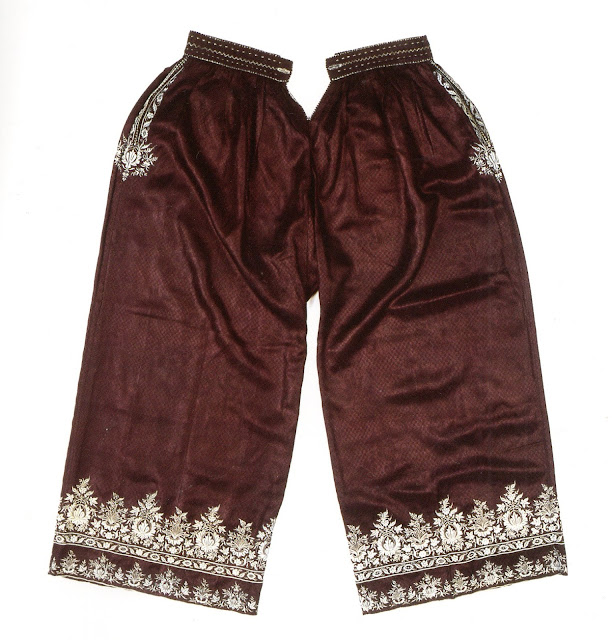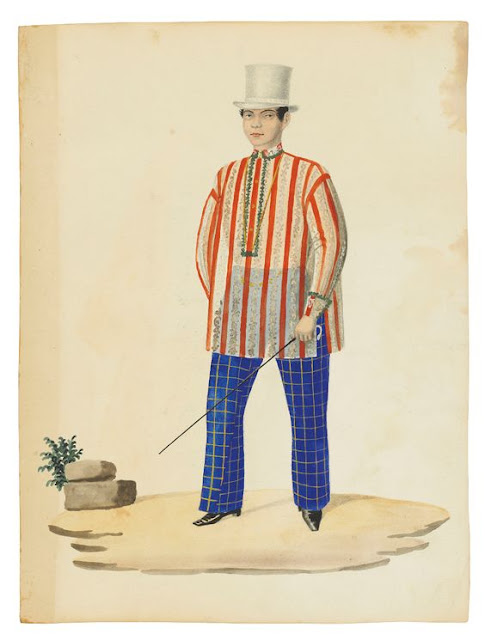Hello All,
I have been asked to do some research into the costumes of the Philippines, and I have found that it is a very extensive subject. Today I will cover some aspects of the national costume of the early 1800's. This costume later changed and developed with time, but I will save those for another article.
This is an ethno-linguistic map of the Philippines. There are almost 200 ethnic groups that inhabit these islands. The earliest inhabitants are today called Negritos. These people were part of an early expansion of humans out of Africa, who colonized much of Southern Asia, Melanesia, and Australia at least 30,000 years ago. Austronesian people arrived about 4,000 years ago and form the vast majority of the Philippine people today. The current inhabitants of the Philippines are usually lumped into 4 groups.
1. Colonists and Migrants. The Spanish began the conquest of these islands in 1565. They have had a presence there ever since, and have had much influence on the culture. There have also been significant influxes of Chinese, Mexicans, Japanese, Indians and Americans, all of which have communities in the Philippines today, and all of which have contributed to the mestizo population.
2. 'Moros'. This is a catch-all term for those ethnic groups who follow Islam. They live mostly in the south, on Mindanao, Sulu and Palawan. Other than their religion, there is little that unites them. These include the Molbog, the Maranao, the Maguindanao and others.
3. 'Indigenous Peoples'. This is the term which is used, but is misleading. This refers to inland and upland groups which have resisted assimilation by the mainstream lowland culture and have retained distinct cultures and identities. These include the Igorot, the Lumad, the Kalinga and many others.
4. 'Lowland Christianized groups'. This is a very clumsy term used to refer to the 19 ethnic groups which do not fall into the other categories. They form the majority of the population. They are just as native to the islands as the 'indigenous' groups are. They have retained their languages, but have assimilated much western culture, as well as Christianity. These include the Tagalog, the Visayans, the Waray and others.
You can read about these groups in greater detail here.
https://en.wikipedia.org/wiki/Ethnic_groups_in_the_Philippines
The Philippine national costume is called Barong Tagalog for men and Baro’t Saya for women. There is little information of what clothing the lowland Filipinos wore before Spanish colonization, but we do have a couple of images from the Boxer Codex. These contain valuable information but one could wish that the artist had more talent, or a more precise eye.
The men are shown wearing a loose shirt, and either a short wrap around the hips or knee length pants, along with a headband and accessories. The women are shown wearing a loose blouse, a wrap skirt and a cloth worn around the shoulders, as well as jewelry. Both have embellishment on their clothing, although it is not clear if it is woven in, embroidered, or sewn on. I am unclear as to how reliable these drawings are.
Trade certainly existed, and silk and cotton were brought in from China, India, and the islands of Indonesia. In the Philippines themselves, cotton was raised in the north, but the two most traditional and iconic fibers used for clothing are Abacá and Piña. Abacá is made from the plant Musa textilis, which is a type of banana with inedible fruit and fibrous leaf stems. https://en.wikipedia.org/wiki/Abac%C3%A1

Piña is a cloth made of fibers from the leaves of the pineapple plant. https://en.wikipedia.org/wiki/Pi%C3%B1a
Both of these textiles are very strong and somewhat stiff, and can easily be woven into a rather gauzy fabric which is suitable to the hot climate of the lowlands of these islands. This is taken full advantage of in the men's shirts called Barong. These are still part of the national costume of the Philippines today, but have changed somewhat over the centuries. They are called Barong Tagalog, but are not restricted to the Tagalog people. They have always been worn untucked, and in their more dressy and formal forms are woven very gauzy and rather transparent, as can be seen in the images at the head of the article. In the early 1800's they were woven with colorful stripes of either silk or cotton. Originally they had embroidery around the neck opening and had open sleeves, like this example from the Rijksmuseum. This one also has a standing collar, lace on the sleeve cuffs and slits on the sides. Sumptuous garments like this were worn for festive occasions by the well off.
This is a native style; these shirts were never worn by the Spanish colonists. The only european influence in this garment is maybe the standing collar. Later on cuffs and fold over collars were added under Spanish influence. The origin of the embroidery tradition is unclear, but it seems to be a mixture of indigenous work combined with influences from China, India, and Europe. Here is another example of a museum piece from the Met. This is made of Piña cloth, has a button up collar, but still has open sleeves. It is woven in colorful stripes with embroidery over the neutral stripes.
The pants varied, some were relatively narrow, long and plain colored. This is what is most commonly seen today. Others were woven in colorful stripes. Yet others were very full, made of black Chinese silk, and varied in length from the knee to the ankle. These were called sayasaya and were a distinctive feature of the men's costume of the early 19th cent. They also featured elaborate white embroidery on the cuffs, around the pockets, and sometimes on the waistbands. Apart from these old drawings, a few specimens are preserved in the Rijksmuseum in the Netherlands. Here are images of them and closeups of the embroidery.
The modern version of the costume is, unfortunately, much plainer. The elaborately embroidered sayasaya are no longer seen. The Barong Tagalog has lost its colorful stripes, as have the pants. The elaborate embroidery is still seen on the Barong of today. I think that this older form should be revived, or a new form developed that echoes the colorful stripes and embroidered pants of the past. Here is a modern example of this outfit.
Here are some images of more recent versions of the barong. New designs are still being made and worn today.
email: rkozakand@aol.com


.png)




,_19th_century_(CH_18386747).jpg)









.jpg)

.jpg)




































.jpg)



















.jpg)
.jpg)

No comments:
Post a Comment